Influence of InP/ZnS Quantum Dots on Thermodynamic Properties and Morphology of the DPPC/DPPG Monolayers at Different Temperatures
Abstract
1. Introduction
2. Results and Discussion
2.1. Surface Pressure–Mean Molecular Area () Isotherms and Elastic Modulus–Surface Pressure () Curves
2.2. Relaxation of the DPPC/DPPG Mixed Monolayers at Constant Area
2.3. The AFM Analysis of the Monolayer
3. Materials and Methods
3.1. Materials
3.2. Monolayers Preparation
3.3. Surface Pressure–Mean Molecular Area () Isotherms
3.4. Relaxation of the DPPC/DPPG Mixed Monolayers at Constant Molecular Area
3.5. Atomic Force Microscope Observation of the Monolayer
4. Conclusions
Supplementary Materials
Author Contributions
Funding
Institutional Review Board Statement
Informed Consent Statement
Data Availability Statement
Conflicts of Interest
Sample Availability
References
- Zhao, L.; Guo, Z.; Wu, H.; Wang, Y.; Zhang, H.; Liu, R. New insights into the release mechanism of Cd2+ from CdTe quantum dots within single cells in situ. Ecotoxicol. Environ. Saf. 2020, 196, 110569. [Google Scholar] [CrossRef] [PubMed]
- Wei, L.; Ye, J.; Zhou, X.; Guo, T.; Ren, C.; Yan, Q.; Zhang, Y.; Wu, C. Improved luminescent InP/ZnS quantum dots by ZnF2 assisted one-pot aminophosphine synthesis strategy. Opt. Mater. 2022, 134, 113209. [Google Scholar] [CrossRef]
- Brunetti, V.; Chibli, H.; Fiammengo, R.; Galeone, A.; Malvindi, M.A.; Vecchio, G.; Cingolani, R.; Nadeau, J.L.; Pompa, P.P. InP/ZnS as a safer alternative to CdSe/ZnS core/shell quantum dots: In vitro and in vivo toxicity assessment. Nanoscale 2013, 5, 307. [Google Scholar] [CrossRef]
- Reiss, P.; Proti`ere, M.; Li, L. Core/shell semiconductor nanocrystals. Small 2009, 5, 154–168. [Google Scholar] [CrossRef]
- Smith, C.T.; Leontiadou, M.A.; Clark, P.C.; Lydon, C.; Savjani, N.; Spencer, B.F.; Flavell, W.R.; O’brien, P.; Binks, D.J. Multiple exciton generation and dynamics in InP/CdS colloidal quantum dots. J. Phys. Chem. C 2017, 121, 2099–2107. [Google Scholar] [CrossRef]
- Liu, Q.; Kong, D. Multi-exciton properties of InP/ZnS core-shell quantum dots. Phys. B Condens. Matter 2022, 646, 414354. [Google Scholar] [CrossRef]
- Zhang, Y.; Wang, T.H. Quantum dot enabled molecular sensing and diagnostics. Theranostics 2012, 2, 631–654. [Google Scholar] [CrossRef]
- Farias, P.M.; Santos, B.S.; Fontes, A. Semiconductor fluorescent quantum dots: Efficient biolabels in cancer diagnostics. Methods Mol. Biol. 2009, 544, 407–419. [Google Scholar]
- Soenen, S.J.; Manshian, B.B.; Aubert, T.; Himmelreich, U.; Demeester, J.; Smedt, S.C.D.; Hens, Z.; Braeckmans, K. Cytotoxicity of Cadmium-Free Quantum Dots and Ther Use in cell bioimaging. Chem. Res. Toxicol. 2014, 27, 1050–1059. [Google Scholar] [CrossRef]
- Paydary, P.; Larese-Casanova, P. Water chemistry influences on long-term dissolution kinetics of CdSe/ZnS quantum dots. J. Environ. Sci. 2020, 90, 216–233. [Google Scholar] [CrossRef]
- Chen, T.; Li, L.; Xu, G.; Wang, X.; Wang, J.; Chen, Y.; Jiang, W.; Yang, Z.; Lin, G. Cytotoxicity of InP/ZnS Quantum Dots With Different Surface Functional Groups Toward Two Lung-Derived Cell Lines. Front. Pharmacol. 2018, 9, 763. [Google Scholar] [CrossRef] [PubMed]
- Zienolddiny, S.; Svendsrud, D.H.; Ryberg, D.; Mikalsen, A.B.; Haugen, A. Nickel(II) induces microsatellite mutations in human lung cancer cell lines. Mutat. Res. 2000, 452, 91–100. [Google Scholar] [CrossRef] [PubMed]
- Schwotzer, D.; Niehof, M.; Schaudien, D.; Kock, H.; Hansen, T.; Dasenbrock, C.; Creutzenberg, O. Cerium oxide and barium sulfate nanoparticle inhalation affects gene expression in alveolar epithelial cells type II. J. Nanobiotechnol. 2018, 16, 16. [Google Scholar] [CrossRef] [PubMed]
- Pedrosa, M.; Maldonado-Valderrama, J.; Gálvez-Ruiz, M.J. Interactions between curcumin and cell membrane models by Langmuir monolayers. Colloids Surf. B Biointerfaces 2022, 217, 112636. [Google Scholar] [CrossRef]
- Pereira, A.R.; Shimizu, F.M.; Oliveira, O.N. Cholesterol modulates the interaction between paclitaxel and Langmuir monolayers simulating cell membranes. Colloids Surf. B Biointerfaces 2021, 205, 111889. [Google Scholar] [CrossRef]
- Cancino-Bernardi, J.; Lins, P.M.P.; Marangoni, V.S.; Faria, H.A.M.; Zucolotto, V. Difference in lipid cell composition and shaped-based gold nanoparticles induce distinguish pathways in Langmuir monolayers response. Mater. Today Commun. 2021, 26, 101831. [Google Scholar] [CrossRef]
- Veldhuizen, E.J.A.; Haagsman, H.P. Role of Pulmonary Surfactant Components in Surface Film Formation and Dynamics. Biochim. Biophys. Acta (BBA)-Biomembr. 2000, 1467, 255–270. [Google Scholar] [CrossRef]
- Hallman, M.; Feldman, B.H.; Kirkpatrick, E.; Gluck, L. Absence of Phosphatidylglycerol (PG) in Respiratory Distress Syndrome in the Newborn. Pediatr. Res. 1977, 11, 714–720. [Google Scholar] [CrossRef]
- Sachan, A.K.; Harishchandra, R.K.; Bantz, C.; Maskos, M.; Reichelt, R.; Galla, H.J. High-Resolution Investigation of Nanoparticle Interaction with a Model Pulmonary Surfactant Monolayer. ACS Nano 2012, 6, 1677–1687. [Google Scholar] [CrossRef]
- Hu, J.; Li, X.; Li, M.; Shang, Y.; He, Y.; Liu, H. Real-Time Monitoring of the Effect of Carbon Nanoparticles on the Surface Behavior of DPPC/DPPG Langmuir Monolayer. Colloids Surf. B Biointerfaces 2020, 190, 110922. [Google Scholar] [CrossRef]
- Wang, J.; Feng, S.; Liu, J.; Liu, R.L. Effects of Carboxyl or Amino Group Modified InP/ZnS Nanoparticles Toward Simulated Lung Surfactant Membrane. Front. Bioeng. Biotechnol. 2021, 9, 714922. [Google Scholar] [CrossRef] [PubMed]
- Zhang, X.; Barraza, K.M.; Upton, K.T.; Beauchamp, J.L. Subtle changes in lipid environment have profound effects on membrane oxidation chemistry. J. Am. Chem. Soc. 2018, 140, 17492–17498. [Google Scholar] [CrossRef] [PubMed]
- Hata, T.; Matsuki, H.; Kaneshina, S. Effect of local anesthetics on the phase transition temperatures of ether- and ester-linked phospholipid bilayer membranes. Colloids Surf. B Biointerfaces 2000, 18, 41–50. [Google Scholar] [CrossRef]
- Istrate, C.M.; Holban, A.M.; Grumezescu, A.M.; Mogoanta, L.; Mogosanu, G.D.; Savopol, T.; Moisescu, M.; Iordache, M.; Vasile, B.S.; Kovacs, E. Iron oxide nanoparticles modulate the interaction of different antibiotics with cellular membranes. Rom. J. Morphol. Embryol. 2014, 55, 849–856. [Google Scholar]
- Kokura, S.; Yoshida, N.; Ueda, M.; Imamoto, E.; Ishikawa, T.; Takagi, T.; Naito, Y.; Okanoue, T.; Yoshikawa, T. Hyperthermia enhances tumor necrosis factor α-induced apoptosis of a human gastric cancer cell line. Cancer Lett. 2003, 201, 89–96. [Google Scholar] [CrossRef]
- Farzin, L.; Saber, R.; Sadjadi, S.; Mohagheghpour, E.; Sheini, A. Nanomaterials-based hyperthermia: A literature review from concept to applications in chemistry and biomedicine. J. Therm. Biol. 2022, 104, 103201. [Google Scholar] [CrossRef]
- Jiang, Z.; Li, T.; Cheng, H.; Zhang, F.; Yang, X.; Wang, S.; Zhou, J.; Ding, Y. Nanomedicine potentiates mild photothermal therapy for tumor ablation. Asian J. Pharm. Sci. 2021, 16, 738–761. [Google Scholar] [CrossRef]
- Wang, R.; Guo, Y.; Liu, H.; Chen, Y.; Shang, Y.; Liu, H. The Effect of Chitin Nanoparticles on Surface Behavior of DPPC/DPPG Langmuir Monolayers. J. Colloid Interface Sci. 2018, 519, 186–193. [Google Scholar] [CrossRef]
- Chen, Q.; Liang, X.; Wang, S.; Xu, S.; Liu, H.; Ying, H. Cationic Gemini surfactant at the air/water interface. J. Colloid Interface Sci. 2007, 314, 651–658. [Google Scholar]
- Song, C.S.; Ye, R.Q.; Mu, B.Z. Molecular Behavior of a Microbial Lipopeptide Monolayer at the Air-Water Interface. Colloids Surf. A Physicochem. Eng. Asp. 2007, 302, 82–87. [Google Scholar] [CrossRef]
- Nakahara, H.; Lee, S.; Sugihara, G.; Chang, C.H.; Shibata, O. Langmuir Monolayer of Artificial Pulmonary Surfactant Mixtures with an Amphiphilic Peptide at the Air/Water Interface: Comparison of New Preparations with Surfacten (Surfactant TA). Langmuir 2008, 24, 3370–3379. [Google Scholar] [CrossRef] [PubMed]
- Harishchandra, R.K.; Wulff, S.; Lentzen, G.; Neuhaus, T.; Galla, H.J. The Effect of Compatible Solute Ectoines on the Structural Organization of Lipid Monolayer and Bilayer Membranes. Biophys. Chem. 2010, 150, 37–46. [Google Scholar] [CrossRef] [PubMed]
- Krajewska, B.; Kyzioł, A.; Wydro, P. Chitosan as a subphase disturbant of membrane lipid monolayers. The effect of temperature at varying pH: II. DPPC and cholesterol. Colloids Surf. A Physicochem. Eng. Asp. 2013, 434, 359–364. [Google Scholar] [CrossRef]
- Gzyl-Malcher, B.; Handzlik, J.; Klekowska, E. Temperature dependence of the interaction of prazosin with lipid Langmuir monolayers. Colloids Surf. B Biointerfaces 2013, 112, 171–176. [Google Scholar] [CrossRef] [PubMed]
- Devterova, J.M.; Sokolov, M.E.; BuzKo, V.Y.; Repina, I.N.; Rudnov, P.S.; Panyushkin, V.T. Subphase pH effect on the limiting molecular area of amphiphilic β-diketones in Langmuir monolayers. Mendeleev Commun. 2020, 30, 505–506. [Google Scholar] [CrossRef]
- Davies, J.T.; Rideal, E.K. Interfacial Phenomena, 2nd ed.; Academic Press: New York, NY, USA, 1963; pp. 265–266. [Google Scholar]
- Panda, A.K.; Possmayer, F.; Petersen, N.O. Physico-chemical studies on mixed oppositely charged surfactants: Their uses in the preparation of surfactant ion selective membrane and monolayer behavior at the air water interface. Colloids Surf. A Physicochem. Eng. Asp. 2005, 264, 106–113. [Google Scholar] [CrossRef]
- Gopal, A.; Lee, K.Y.C. Headgroup percolation and collapse of condensed Langmuir monolayers. J. Phys. Chem. B 2006, 110, 22079–22089. [Google Scholar] [CrossRef]
- Gzyl-Malcher, B.; Handzlik, J.; Klekowska, E. Interaction of prazosin with model membranes—A Langmuir monolayer study. Bioelectrochemistry 2012, 87, 96–103. [Google Scholar] [CrossRef]
- Xu, G.Q.; Hao, C.C.; Zhang, L.; Sun, R.G. The interaction between BSA and DOTAP at the airbuffer interface. Sci. Rep. 2018, 8, 407. [Google Scholar] [CrossRef]
- Wang, J.; Ma, Y.; Hou, S.; Miao, Z.; Ma, Q. Interaction of amphotericin B and saturated or unsaturated phospholipid monolayers containing cholesterol or ergosterol at the air-water interface. Biophys. Chem. 2020, 258, 106317. [Google Scholar] [CrossRef]
- Chen, X.; Wang, J.; Shen, N.; Luo, Y.; Li, L.; Liu, M.; Thomas, R.K. Gemini Surfactant/DNA Complex Monolayers at the Air-Water Interface: Effect of Surfactant Structure on the Assembly, Stability, and Topography of Monolayers. Langmuir 2002, 18, 6222. [Google Scholar] [CrossRef]
- Guzmán, E.; Liggieri, L.; Santini, E.; Ferrari, M.; Ravera, F. DPPC–DOPC Langmuir monolayers modified by hydrophilic silica nanoparticles: Phase behaviour, structure and rheology. Colloids Surf. A Physicochem. Eng. Asp. 2012, 413, 174–183. [Google Scholar] [CrossRef]
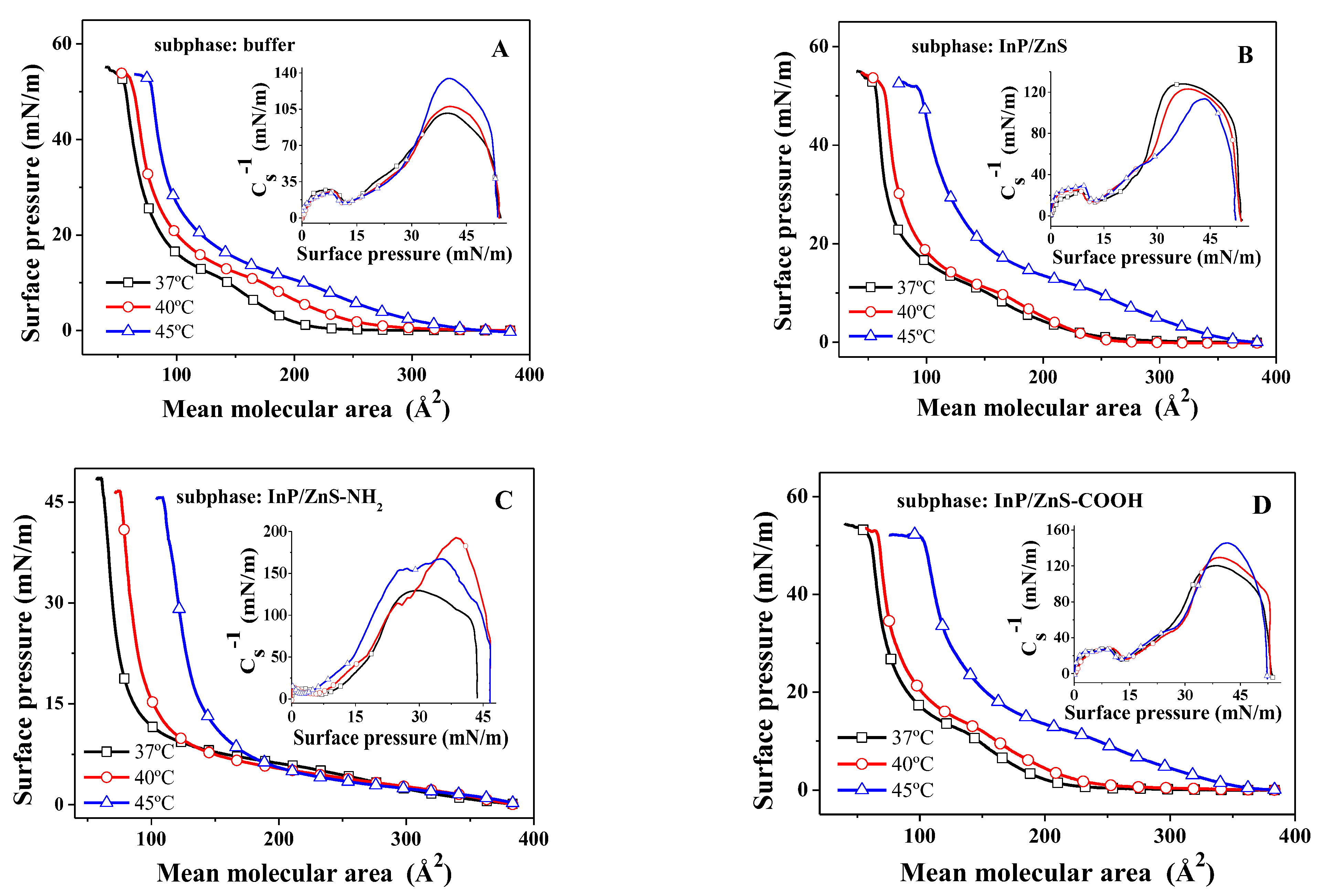
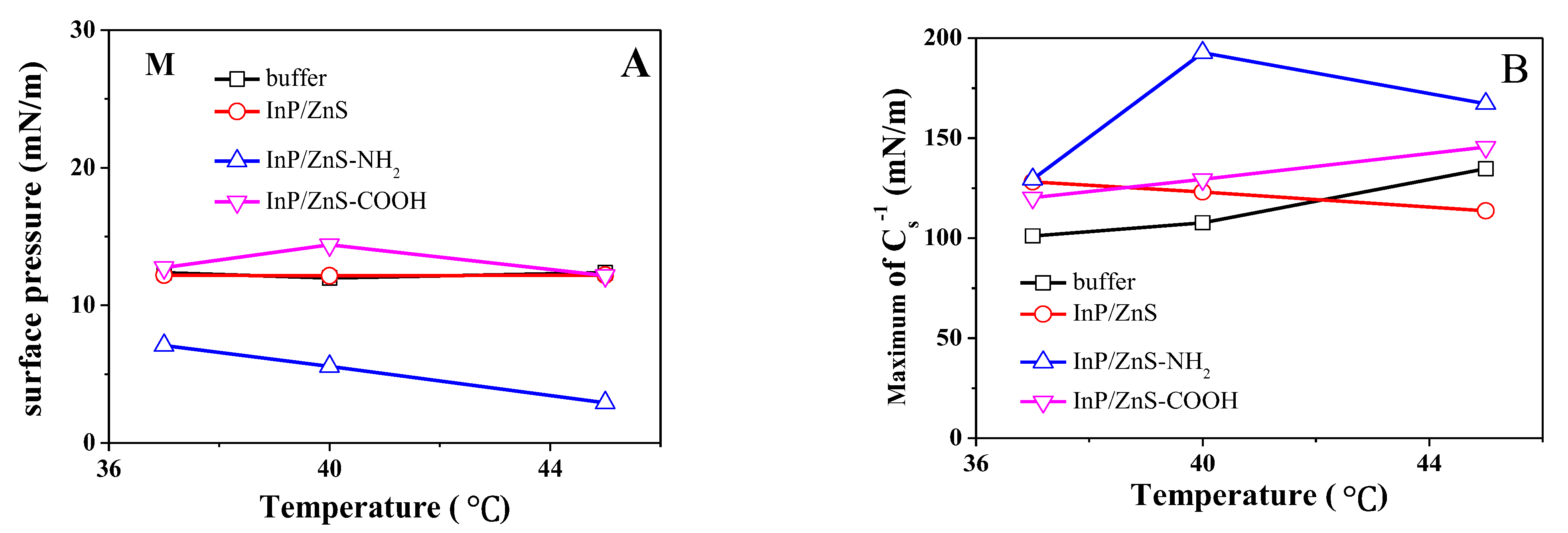
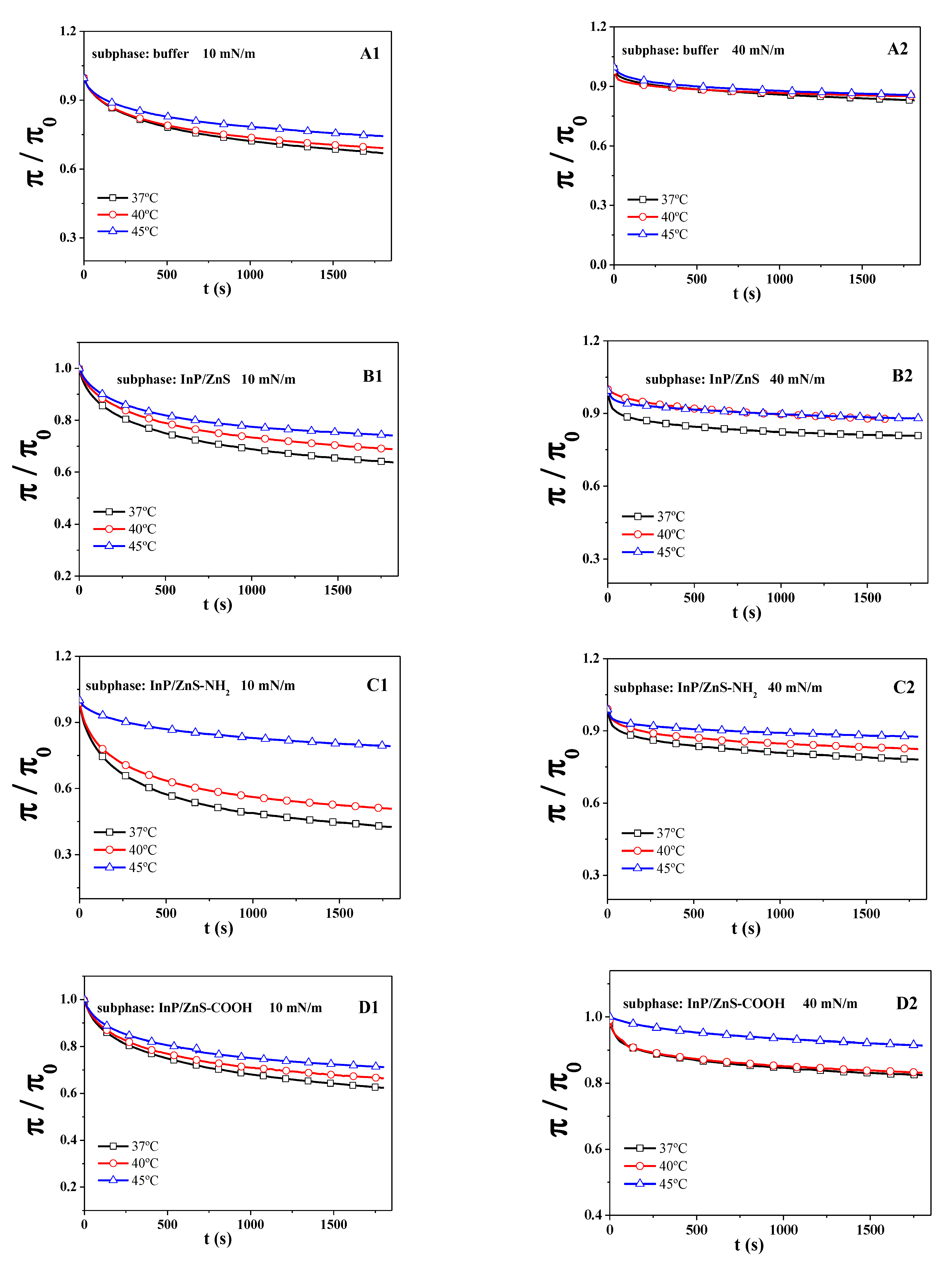
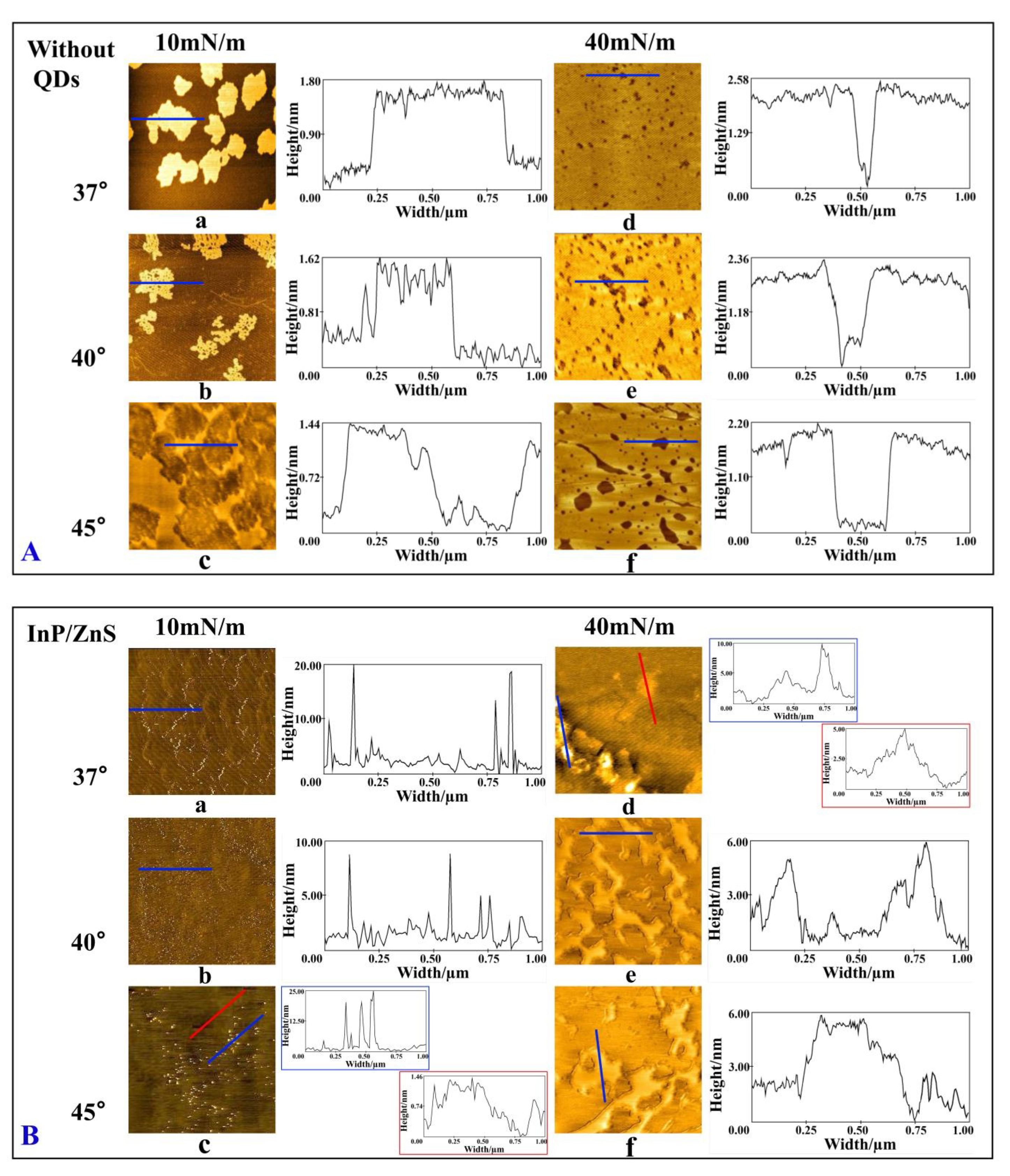
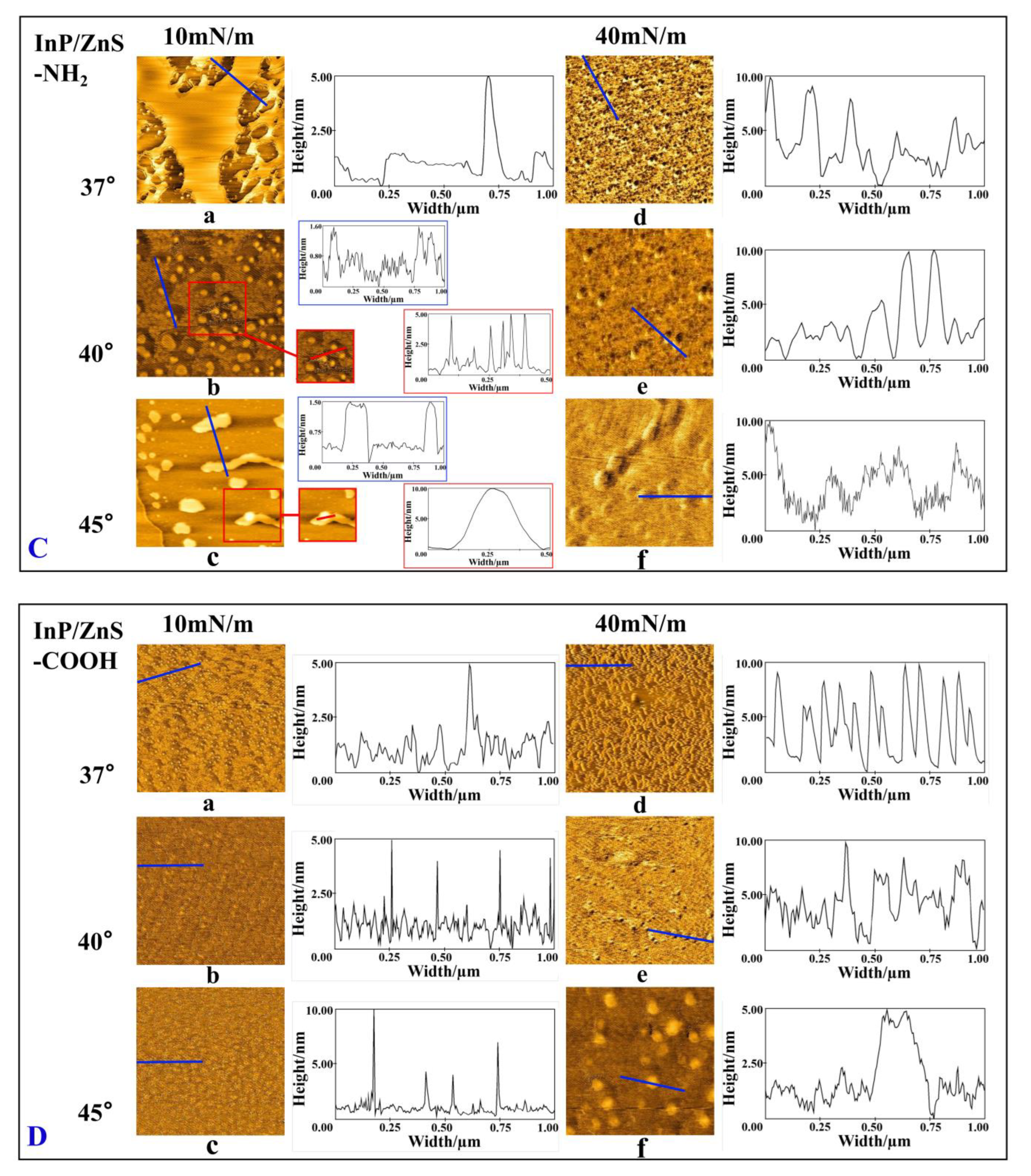

| Subphase | Temperature/°C | ||||
|---|---|---|---|---|---|
| Without QDs | 37 | 233.83 | 90.51 | 53.04 | 52.73 |
| 40 | 293.53 | 97.32 | 52.76 | 60.87 | |
| 45 | 350.36 | 114.28 | 52.20 | 76.92 | |
| InP/ZnS | 37 | 259.54 | 74.9 | 52.73 | 54.43 |
| 40 | 259.54 | 84.16 | 51.79 | 62.37 | |
| 45 | 364.48 | 143.15 | 51.54 | 92.85 | |
| InP/ZnS-NH2 | 37 | 376.74 | 82.44 | 48.56 | 61.51 |
| 40 | 376.74 | 102.72 | 46.95 | 74.65 | |
| 45 | 376.74 | 142.86 | 45.66 | 106.72 | |
| InP/ZnS-COOH | 37 | 237.25 | 89.02 | 52.66 | 57.46 |
| 40 | 271.98 | 94.22 | 52.63 | 65.76 | |
| 45 | 365.29 | 142.66 | 51.88 | 100.42 |
| Buffer Solution | T/°C | 10 mN/m | 40 mN/m | ||||||
|---|---|---|---|---|---|---|---|---|---|
| Without QDs | 37 | 0.83 | 0.14 | 592.53 | 0.99 | 0.82 | 0.12 | 781.20 | 0.98 |
| 40 | 0.85 | 0.13 | 553.45 | 0.99 | 0.85 | 0.08 | 591.03 | 0.98 | |
| 45 | 0.87 | 0.10 | 611.02 | 0.99 | 0.86 | 0.11 | 549.07 | 0.98 | |
| InP/ZnS | 37 | 0.82 | 0.14 | 534.72 | 0.99 | 0.81 | 0.11 | 464.45 | 0.98 |
| 40 | 0.84 | 0.13 | 546.15 | 0.99 | 0.87 | 0.11 | 705.51 | 0.99 | |
| 45 | 0.87 | 0.11 | 484.8 | 0.99 | 0.87 | 0.08 | 832.33 | 0.99 | |
| InP/ZnS-NH2 | 37 | 0.71 | 0.23 | 407.19 | 0.99 | 0.78 | 0.13 | 634.52 | 0.97 |
| 40 | 0.76 | 0.18 | 448.64 | 0.99 | 0.82 | 0.11 | 505.87 | 0.97 | |
| 45 | 0.89 | 0.09 | 636.36 | 0.99 | 0.87 | 0.07 | 652.70 | 0.97 | |
| InP/ZnS-COOH | 37 | 0.81 | 0.15 | 553.85 | 0.99 | 0.82 | 0.11 | 523.40 | 0.97 |
| 40 | 0.83 | 0.14 | 523.05 | 0.99 | 0.83 | 0.11 | 530.77 | 0.96 | |
| 45 | 0.85 | 0.14 | 517.25 | 0.99 | 0.91 | 0.08 | 829.54 | 0.99 | |
| Buffer Solution | T/ °C | Distribution of Nanoparticles on the LE Phase of Monolayer | Distribution of Nanoparticles on the LC Phase of Monolayer | ||
|---|---|---|---|---|---|
| Position | Form | Position | Form | ||
| InP/ZnS | 37 | penetrate | Single, aggregated | Penetrate, adsorb on the interface | Single, aggregated |
| 40 | penetrate | Single, aggregated | adsorb on the interface | Single, aggregated | |
| 45 | penetrate | Single, aggregated | adsorb on the interface | Single, aggregated | |
| InP/ZnS-NH2 | 37 | penetrate | Single | penetrate | Single, aggregated |
| 40 | penetrate | Single | penetrate | Single, aggregated | |
| 45 | penetrate | aggregated | penetrate | aggregated | |
| InP/ZnS-COOH | 37 | penetrate | Single | penetrate | Single, aggregated |
| 40 | penetrate | Single | penetrate | aggregated | |
| 45 | penetrate | Single, aggregated | penetrate | aggregated | |
Disclaimer/Publisher’s Note: The statements, opinions and data contained in all publications are solely those of the individual author(s) and contributor(s) and not of MDPI and/or the editor(s). MDPI and/or the editor(s) disclaim responsibility for any injury to people or property resulting from any ideas, methods, instructions or products referred to in the content. |
© 2023 by the authors. Licensee MDPI, Basel, Switzerland. This article is an open access article distributed under the terms and conditions of the Creative Commons Attribution (CC BY) license (https://creativecommons.org/licenses/by/4.0/).
Share and Cite
Wang, J.; Feng, S.; Sheng, Q.; Liu, R. Influence of InP/ZnS Quantum Dots on Thermodynamic Properties and Morphology of the DPPC/DPPG Monolayers at Different Temperatures. Molecules 2023, 28, 1118. https://doi.org/10.3390/molecules28031118
Wang J, Feng S, Sheng Q, Liu R. Influence of InP/ZnS Quantum Dots on Thermodynamic Properties and Morphology of the DPPC/DPPG Monolayers at Different Temperatures. Molecules. 2023; 28(3):1118. https://doi.org/10.3390/molecules28031118
Chicago/Turabian StyleWang, Juan, Shun Feng, Qingqing Sheng, and Ruilin Liu. 2023. "Influence of InP/ZnS Quantum Dots on Thermodynamic Properties and Morphology of the DPPC/DPPG Monolayers at Different Temperatures" Molecules 28, no. 3: 1118. https://doi.org/10.3390/molecules28031118
APA StyleWang, J., Feng, S., Sheng, Q., & Liu, R. (2023). Influence of InP/ZnS Quantum Dots on Thermodynamic Properties and Morphology of the DPPC/DPPG Monolayers at Different Temperatures. Molecules, 28(3), 1118. https://doi.org/10.3390/molecules28031118







